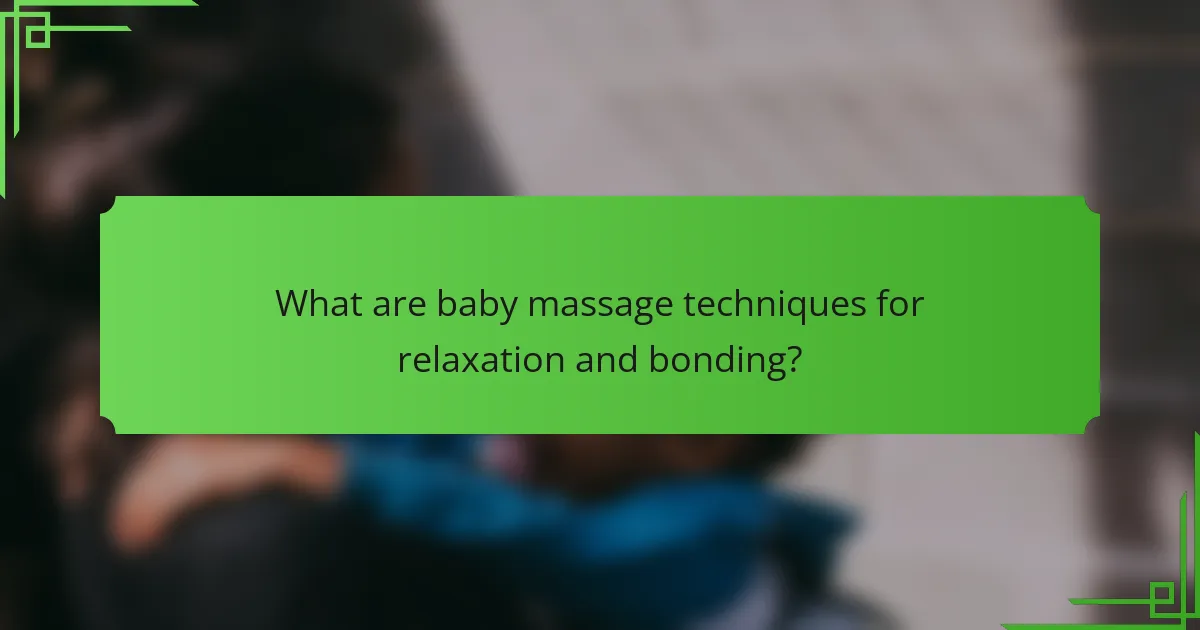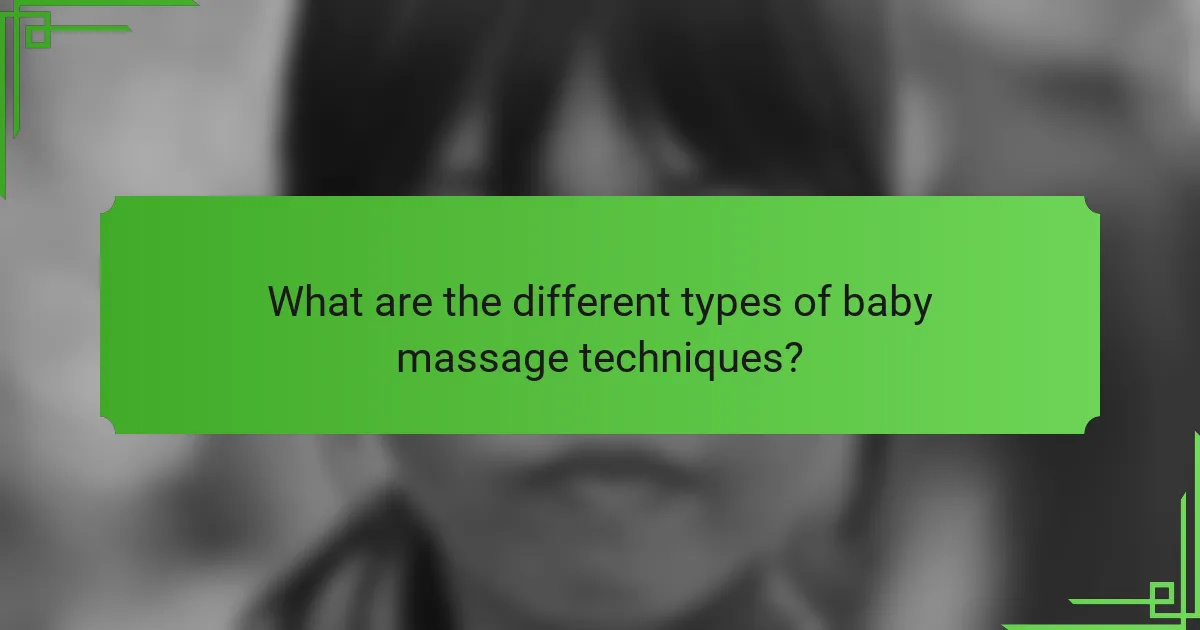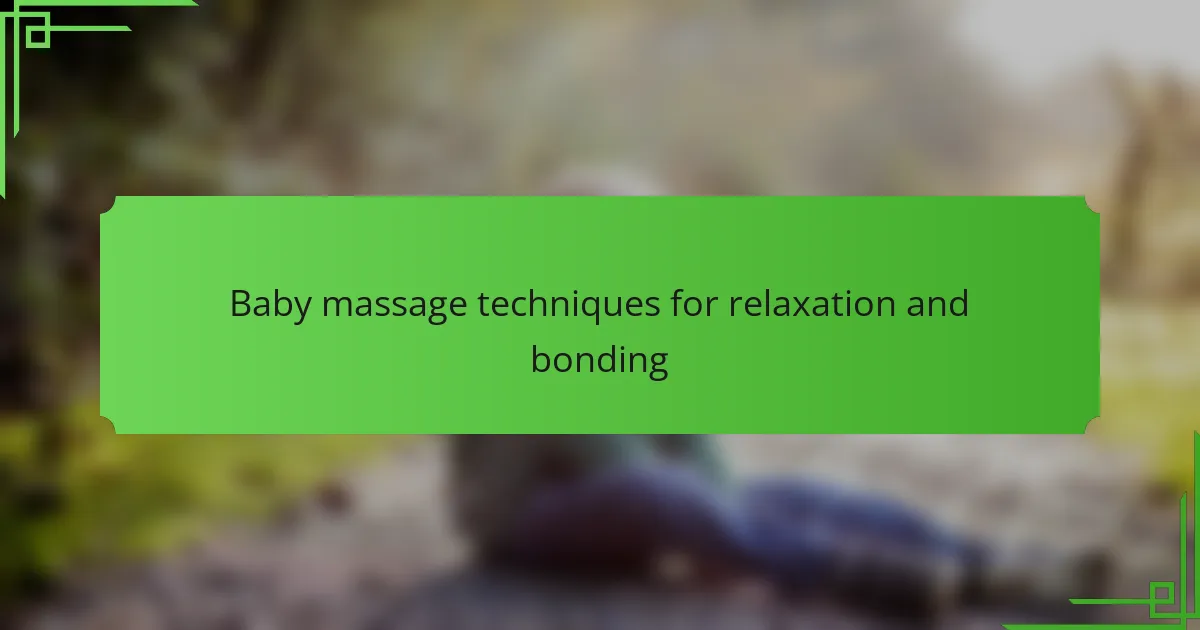Baby massage techniques are essential practices that foster relaxation and bonding between caregivers and infants. Key techniques include gentle strokes, circular motions, and tapping, each serving distinct purposes such as soothing, aiding digestion, and promoting relaxation. Research supports the benefits of baby massage, indicating it can reduce stress and enhance sleep quality in infants. Various methods like effleurage, petrissage, friction, tapotement, and vibration offer unique advantages for physical and emotional development. Best practices for effective baby massage involve creating a calm environment and using gentle techniques while observing the baby’s responses.

What are baby massage techniques for relaxation and bonding?
Baby massage techniques for relaxation and bonding include gentle strokes, circular motions, and tapping. These techniques promote physical and emotional connection between the caregiver and the baby. Gentle strokes along the arms and legs help soothe the baby. Circular motions on the tummy can aid digestion and provide comfort. Tapping lightly on the back can stimulate relaxation. Research indicates that massage can reduce infant stress and promote better sleep. The Journal of Pediatrics published a study showing that regular massage increases bonding and enhances emotional development.
How do baby massage techniques promote relaxation?
Baby massage techniques promote relaxation by stimulating the release of oxytocin. Oxytocin is a hormone that fosters bonding and reduces stress. The gentle touch during massage also calms the nervous system. This leads to decreased heart rate and lower cortisol levels. Research shows that massage can improve sleep quality in infants. A study published in the Journal of Pediatrics found that babies who received massage showed fewer signs of stress. Additionally, massage enhances blood circulation, which contributes to overall comfort. These physiological changes create a serene environment for the baby.
What physiological effects does baby massage have on infants?
Baby massage has several physiological effects on infants. It promotes relaxation and reduces stress levels. Massage stimulates circulation, enhancing blood flow throughout the body. It also aids digestion and can alleviate colic symptoms. Research indicates that massage can improve sleep quality in infants. Additionally, it supports the development of motor skills. Studies show that infants who receive regular massage may exhibit increased weight gain. The nurturing touch during massage fosters emotional bonding between the caregiver and the infant.
How does touch influence a baby’s emotional development?
Touch significantly influences a baby’s emotional development. It fosters secure attachment and emotional regulation. Skin-to-skin contact releases oxytocin, promoting bonding. Research shows that infants who receive regular touch exhibit lower stress levels. Touch can also enhance a baby’s mood and reduce crying. Studies indicate that massage therapy improves sleep patterns in babies. Furthermore, tactile stimulation supports sensory development, which is crucial for emotional growth. Overall, touch plays a vital role in shaping a baby’s emotional landscape.
Why is bonding important in the context of baby massage?
Bonding is crucial in the context of baby massage because it fosters emotional connection between the caregiver and the infant. This physical touch enhances feelings of safety and security for the baby. Through consistent massage, caregivers can communicate love and affection non-verbally. Research indicates that such bonding experiences can lead to improved emotional and social development in infants. A study published in the Journal of Pediatric Health Care found that infants who received regular massage exhibited better attachment behaviors. Moreover, bonding during massage can reduce stress levels for both the baby and the caregiver. This creates a nurturing environment that supports overall well-being.
What role does skin-to-skin contact play in bonding?
Skin-to-skin contact plays a crucial role in bonding between caregivers and infants. This physical closeness promotes emotional attachment and security. It triggers the release of oxytocin, often referred to as the “bonding hormone.” Research shows that skin-to-skin contact enhances the infant’s physiological stability. It can lead to improved heart rate and temperature regulation in newborns. Studies indicate that infants who experience skin-to-skin contact cry less and gain weight more effectively. This practice also fosters a sense of safety and comfort for the baby. Overall, skin-to-skin contact significantly strengthens the emotional connection between parent and child.
How can baby massage enhance parent-child relationships?
Baby massage enhances parent-child relationships by promoting physical closeness and emotional bonding. The act of massage fosters skin-to-skin contact, which is crucial for infant attachment. Research indicates that this tactile interaction releases oxytocin, the bonding hormone, in both parent and child. Increased oxytocin levels can lead to improved emotional connection and trust. Additionally, baby massage can reduce stress for both the parent and the infant, creating a calmer environment. Studies show that regular massage can improve parental sensitivity, leading to better communication and understanding. This nurturing practice also encourages parents to be more attuned to their baby’s needs. Overall, baby massage serves as a powerful tool for strengthening the parent-child bond.

What are the different types of baby massage techniques?
There are several types of baby massage techniques. These techniques include effleurage, petrissage, friction, tapotement, and vibration. Effleurage involves gentle, gliding strokes that promote relaxation. Petrissage consists of kneading movements that help relieve tension. Friction uses circular motions to stimulate the skin and muscles. Tapotement includes rhythmic tapping to invigorate the baby. Vibration is a technique that uses rapid shaking to soothe and calm. Each technique serves a unique purpose in enhancing relaxation and bonding between the caregiver and the baby.
How do various techniques differ in their approach?
Various baby massage techniques differ in their approach by targeting specific outcomes and using distinct methods. For instance, Swedish massage focuses on gentle strokes to promote relaxation. This technique emphasizes long, flowing movements that help soothe the baby. In contrast, Indian massage incorporates rhythmic pressure and stretching to enhance bonding. This method often involves parents actively engaging with their baby during the massage. Additionally, infant massage techniques may utilize specific strokes for colic relief, focusing on the abdomen to ease discomfort. These varied approaches cater to different needs, such as relaxation, bonding, or alleviating discomfort. Research indicates that these techniques can significantly impact a baby’s emotional and physical well-being.
What are the key characteristics of Swedish baby massage?
Swedish baby massage is a gentle technique focusing on relaxation and bonding. It incorporates long, gliding strokes to promote comfort. The strokes are rhythmic and soothing, enhancing the baby’s sense of security. This massage style often includes kneading and circular movements to stimulate circulation. The use of natural oils is common, ensuring the baby’s skin remains moisturized. Swedish baby massage encourages the release of oxytocin, strengthening the parent-child bond. Research indicates that such techniques can reduce infant stress and improve sleep patterns. Overall, it fosters emotional connection and physical well-being.
How does Indian baby massage differ from other techniques?
Indian baby massage differs from other techniques primarily in its use of warm oils and specific strokes. Traditional Indian methods emphasize the use of natural oils like sesame or coconut oil. These oils are believed to nourish the skin and enhance bonding through tactile stimulation.
The strokes used in Indian baby massage are often rhythmic and gentle, promoting relaxation and comfort. This technique is based on Ayurvedic principles, which focus on holistic well-being.
Research indicates that Indian baby massage can improve sleep quality and reduce colic in infants. A study published in the Journal of Pediatric Health Care found that infants receiving Indian massage exhibited fewer crying episodes compared to those who did not.
In contrast, Western techniques may prioritize different oils and have varied stroke patterns, focusing more on physical development than emotional bonding.
What tools or products can enhance baby massage experiences?
Baby massage experiences can be enhanced with several tools and products. Massage oils specifically designed for infants are beneficial. They provide lubrication and can soothe the baby’s skin. Soft, warm towels can also enhance the experience by keeping the baby comfortable. A baby massage book or guide can offer techniques and tips for parents. Additionally, calming music or white noise machines can create a relaxing atmosphere during the massage. Some parents find that using a massage mat or blanket provides a designated space for the activity. These tools and products collectively contribute to a more enjoyable and effective baby massage session.
What types of oils are safe for baby massage?
Coconut oil, sweet almond oil, and jojoba oil are safe for baby massage. Coconut oil is known for its moisturizing properties and is gentle on sensitive skin. Sweet almond oil is rich in vitamins and is easily absorbed, making it ideal for massage. Jojoba oil closely resembles the natural oils of the skin, which enhances its compatibility with baby skin. These oils are commonly recommended by pediatricians and are generally safe for infants. Always perform a patch test before full application to ensure no allergic reactions occur.
How can massage tools be effectively used for infants?
Massage tools can be effectively used for infants by providing gentle stimulation and comfort. Soft, age-appropriate tools are designed to enhance the massage experience. These tools can help soothe sore muscles and promote relaxation. Using tools like soft brushes or silicone massagers can also improve blood circulation. Parents should ensure that the tools are clean and safe for infant use. It is important to apply light pressure to avoid discomfort. Research shows that massage can improve sleep quality in infants. The American Academy of Pediatrics supports the use of gentle massage for bonding and relaxation.

What are the best practices for performing baby massage?
The best practices for performing baby massage include creating a calm environment. Ensure the room is warm and quiet. Use gentle, soothing strokes to promote relaxation. Start with the baby’s legs and gradually move to the arms and torso. Always maintain eye contact to enhance bonding. Use a natural oil, like almond or coconut, to prevent friction. Observe the baby’s reactions to adjust pressure and technique. Lastly, keep sessions short, ideally around 10 to 15 minutes, to avoid overstimulation.
How can parents prepare for a baby massage session?
Parents can prepare for a baby massage session by creating a calm environment. This includes choosing a quiet, comfortable space with a warm temperature. Parents should gather all necessary items beforehand, such as a soft blanket, baby oil, and towels. It is important to ensure the baby is in a relaxed state, possibly after a bath or feeding. Parents should also wash their hands thoroughly to maintain hygiene. Engaging in gentle talking or singing can help soothe the baby before starting. Research indicates that a peaceful atmosphere enhances the benefits of baby massage, promoting relaxation and bonding.
What environment is ideal for baby massage?
An ideal environment for baby massage is warm, quiet, and comfortable. The temperature should be between 75°F to 80°F to keep the baby cozy. Soft lighting helps create a calming atmosphere. A flat, soft surface like a mat or blanket is essential for safety and comfort. Minimize distractions by turning off loud devices and ensuring a peaceful setting. Aromatherapy with gentle scents can enhance relaxation. These factors contribute to a soothing experience for both the baby and the caregiver.
How can parents ensure their baby is comfortable during massage?
Parents can ensure their baby is comfortable during massage by creating a soothing environment. They should choose a warm room to prevent the baby from feeling cold. Using soft, gentle strokes is essential to promote relaxation. Parents can also use baby-safe oils to enhance comfort during the massage. Maintaining eye contact and speaking softly helps to reassure the baby. Parents should watch for signs of discomfort, such as fussiness or tensing up. Adjusting pressure and techniques based on the baby’s reactions is crucial. Establishing a routine can help the baby feel more secure during massage sessions. These practices collectively contribute to a positive massage experience for the baby.
What tips can help maximize the benefits of baby massage?
To maximize the benefits of baby massage, create a calm environment. Soft lighting and soothing music can enhance relaxation. Use gentle, consistent strokes to promote comfort. Focus on areas like the back, arms, and legs. Maintain eye contact to strengthen bonding. Choose the right time when the baby is alert but not hungry. Warm your hands before starting to ensure comfort. Lastly, observe the baby’s reactions and adjust techniques accordingly. Research indicates that these practices improve emotional connection and physical well-being in infants.
How can parents read their baby’s cues during massage?
Parents can read their baby’s cues during massage by observing body language and [censured] expressions. For example, a relaxed body indicates comfort, while stiffening may signal discomfort. Crying often suggests that the baby needs a break or is unhappy. Eye contact can show engagement, while looking away might indicate a desire to stop. Parents should also pay attention to coos or gurgles as signs of enjoyment. Additionally, babies may arch their back or push away if they want to end the massage. Understanding these cues helps parents adjust their technique for the baby’s comfort. Research shows that responsive care improves bonding and relaxation during massage.
What common mistakes should be avoided in baby massage?
Common mistakes to avoid in baby massage include using excessive pressure. Babies have sensitive skin and muscles. Gentle strokes are more appropriate. Another mistake is not observing the baby’s cues. Babies may show discomfort or disinterest. Ignoring these signals can lead to a negative experience. Additionally, massaging immediately after feeding is not advisable. This can cause discomfort or reflux. It’s also important to avoid massaging when the baby is unwell. Doing so can exacerbate their condition. Lastly, neglecting to create a calm environment can hinder relaxation. A quiet, warm space enhances the massage experience.
Baby massage techniques for relaxation and bonding involve various methods such as gentle strokes, circular motions, and tapping, which foster emotional and physical connections between caregivers and infants. These techniques promote relaxation by stimulating the release of oxytocin, enhancing blood circulation, and aiding digestion, ultimately improving sleep quality and reducing stress levels. The article discusses different types of baby massage, including Swedish and Indian techniques, and highlights the importance of creating a calm environment, using safe oils, and observing the baby’s cues for a positive experience. Additionally, it emphasizes the role of touch in emotional development and the significance of bonding during massage sessions.
